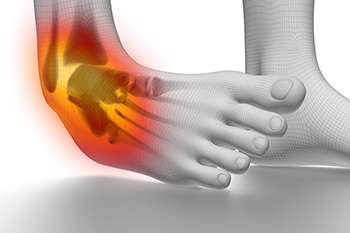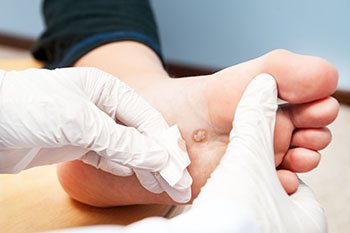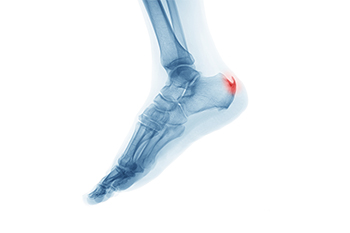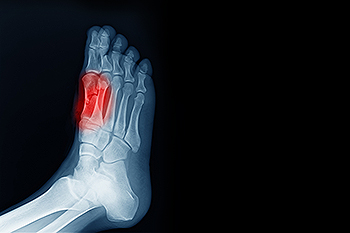September 2024
 Ankle sprains occur when the ligaments supporting the ankle stretch or tear, often due to sudden twists, rolls, or impacts. Common activities leading to sprains include sports, walking on uneven surfaces, or any abrupt movement that forces the ankle out of its normal position. Anyone can suffer an ankle sprain, but athletes, active individuals, and those with previous ankle injuries are at a higher risk. Symptoms can include pain, swelling, bruising, and difficulty bearing weight. Preventing ankle sprains involves regular strength and balance exercises, wearing appropriate footwear, and using ankle supports during high-risk activities. Immediate treatment includes rest, compression, and elevation. Mild pain relievers can help to manage pain and swelling. If you have sustained a severe ankle sprain, it is suggested that you seek medical attention from a chiropodist for a proper diagnosis and treatment.
Ankle sprains occur when the ligaments supporting the ankle stretch or tear, often due to sudden twists, rolls, or impacts. Common activities leading to sprains include sports, walking on uneven surfaces, or any abrupt movement that forces the ankle out of its normal position. Anyone can suffer an ankle sprain, but athletes, active individuals, and those with previous ankle injuries are at a higher risk. Symptoms can include pain, swelling, bruising, and difficulty bearing weight. Preventing ankle sprains involves regular strength and balance exercises, wearing appropriate footwear, and using ankle supports during high-risk activities. Immediate treatment includes rest, compression, and elevation. Mild pain relievers can help to manage pain and swelling. If you have sustained a severe ankle sprain, it is suggested that you seek medical attention from a chiropodist for a proper diagnosis and treatment.
When one or more ligaments in the ankle overstretch or tear due to injury, an ankle sprain occurs. If you would like to learn more about ankle sprains, please consult with one of the chiropodists from The Footcare Centre. Our chiropodists can help you maintain the health of your lower limbs and your mobility.
Symptoms of an ankle sprain vary depending on the severity of the injury, but may include:
Pain
Swelling
Bruising
Tenderness
Difficulty walking
Ankle instability
A reduced range of motion in the ankle
Treatments for an ankle sprain may consist of:
Resting the injured ankle
Applying ice
Elevating the ankle
Compressing the ankle
Over-the-counter pain medications
Ankle braces or other devices to take weight off of the ankle
Ankle exercises
Surgery (in rare cases)
It’s important for the sprained ankle to heal correctly and fully in order to avoid repeated injury. If you have any questions, please feel free to contact our office located in . We offer the newest diagnostic and treatment technologies for all your foot care needs.

Plantar warts are small, non-cancerous growths that appear on the soles of the feet due to the human papillomavirus, or HPV. These warts often develop in areas subjected to pressure, making them uncomfortable and painful. The virus enters the skin through tiny cuts or abrasions and thrives in warm, moist environments like public swimming pools and locker rooms. Plantar warts may have a rough texture and sometimes feature tiny black dots, which are small blood vessels. They are contagious and can spread through direct contact or indirectly via surfaces that have been in contact with the virus. Treatments include mild medications, cryotherapy, or other medical interventions. Proper foot hygiene and avoiding direct contact with warts are essential in preventing their spread. Plantar warts can be painful and can interfere with completing daily activities. If you have developed this condition, it is suggested that you visit a chiropodist who can offer the treatment that is right for you.
Plantar warts can be uncomfortable or even painful. If you’re suffering from warts on your feet, please consult with one of the chiropodists from The Footcare Centre. Our chiropodists can help you maintain the health of your lower limbs and your mobility.
What Does a Plantar Wart Look Like?
Plantar warts are fleshy growths that generally have a rough, grainy texture. They may look and feel like a callus and are usually small and can grow individually or in clusters. Plantar warts may have small, black dots at their center that are actually tiny blood vessels. Warts interrupt the natural lines of your skin.
Treatment Options
Salicylic acid - A chemical solution applied directly to the wart
Cryotherapy - Freezing the wart off with liquid nitrogen
Minor surgery - Removing the wart through excision
Laser treatment - A concentrated beam of light is used to remove the wart
Wearing comfortable shoes and socks to avoid irritating the wart
Over-the-counter medications for pain relief
Patches to keep pressure off the warts
Plantar warts can go away on their own, but this may take several months to years. If your plantar warts are bothering you, seeking medical treatment is suggested. If you have any questions, please feel free to contact our office located in . We offer the newest diagnostic and treatment technologies for all your foot care needs.

Heel spurs are bony growths that develop on the underside of the heel bone, often causing significant pain and discomfort. They typically form over time due to repetitive strain on the foot muscles and ligaments, leading to calcium deposits that build up and create a spur. Heel spurs are commonly associated with plantar fasciitis, a condition characterized by inflammation of the plantar fascia, the thick band of tissue running along the bottom of the foot. People with heel spurs may experience sharp pain, especially when standing up after long periods of rest, or after prolonged activity. Risk factors include obesity, wearing poorly fitting shoes, and engaging in activities that place excessive stress on the heel, such as running or jumping. Treatment often involves rest, stretching exercises, and wearing supportive footwear or orthotic inserts. In severe cases, corticosteroid injections or surgery may be necessary to alleviate pain and remove the spur. If you have a heel spur that is causing persistent discomfort, it is suggested that you visit a chiropodist for a proper diagnosis and a treatment plan.
Heel spurs are bony outgrowths from calcium deposits. They occur at the back of the heel bone or underneath the heel bone and usually form in response to chronic irritation of the Achilles tendon or plantar fascia. They are often asymptomatic, but if you are suffering from heel pain, please consult with one of the chiropodists from The Footcare Centre. Our chiropodists can help you maintain the health of your lower limbs and your mobility.
Symptoms of Heel Spurs
Tenderness
Heel pain
Pain when walking
No symptoms
Diagnosis
Since heel spurs are often asymptomatic, they are usually only diagnosed when they are found on the heels incidentally during an X-ray taken for another reason. Nevertheless, if you have heel pain, and particularly if you have plantar fasciitis or Achilles tendonitis, it may be worth it to see if you have heel spurs too.
Treatment
Unless they are causing symptoms, heel spurs typically don’t require any treatment. When they are symptomatic, treatments are typically conservative. They may include resting and icing the affected foot, taking anti-inflammatory medications, and wearing orthotics or supportive footwear, especially while exercising.
If you have any questions, please feel free to contact our office located in . We offer the newest diagnostic and treatment technologies for all your foot care needs.

Sesamoiditis is the inflammation of the sesamoid bones, which are two small bones located beneath the big toe joint. These bones play a vital role in the movement and function of the toe. The inflammation is often caused by repetitive stress or trauma, such as that experienced from high-impact sports or frequent activities involving the toes. Another possible cause is osteonecrosis, where the blood supply to the sesamoid bones is compromised, leading to bone death and pain. Autoimmune diseases, such as rheumatoid arthritis, can also contribute to inflammation of these bones, as can infections that affect the surrounding tissues. Proper diagnosis and treatment are essential to manage symptoms and prevent long-term damage. If you have pain under your big toe, it is suggested that you consult a chiropodist to find out if the problem is sesamoiditis.
Sesamoiditis is a painful injury to one or both of the two tiny bones located in the ball of the foot. If you have symptoms of sesamoiditis, please consult with one of the chiropodists from The Footcare Centre. Our chiropodists can help you maintain the health of your lower limbs and your mobility.
What is sesamoiditis?
The sesamoid consists of two small, pea-shaped bones located in the ball of the foot beneath the big toe. These bones can be injured and broken or inflamed, leading to foot pain and a variety of other symptoms. Sesamoiditis is common in dancers, joggers, people who have high arches, and people who wear high heels frequently.
Symptoms
Pain beneath the base of the big toe
Pain while walking or wearing certain types of shoes
Swelling
Warmth
Redness in the big toe
Diagnosis
Sesamoiditis can be diagnosed through physical examination. Your chiropodist may also wish to take an X-ray or MRI to determine if the bones are fractured, displaced, or affected by arthritis. If there is a different suspected underlying cause, such as gout or an infection, your chiropodist may also need to take a sample of joint fluid.
Treatment
Treatments for sesamoiditis are usually conservative. You may be asked to wear more comfortable, supportive shoes with a wider toe area, thick sole, and low heel. A chiropodist can also prescribe orthotic inserts that you can put in your shoes. Nonsteroidal anti-inflammatory medications can be taken to help manage pain. In more severe cases, corticosteroid injections into the ball of the foot may be needed for pain management.
If you have any questions, please feel free to contact our office located in . We offer the newest diagnostic and treatment technologies for all your foot care needs.
Blog Archives
- 2025
- 2024
- 2023
- 2022
- 2021
- 2020


